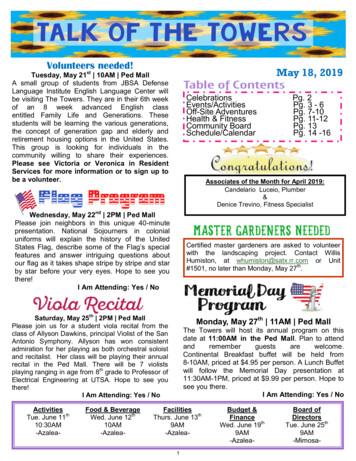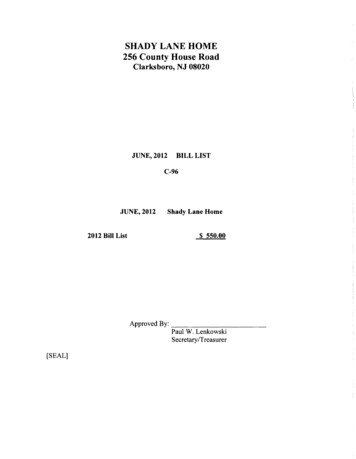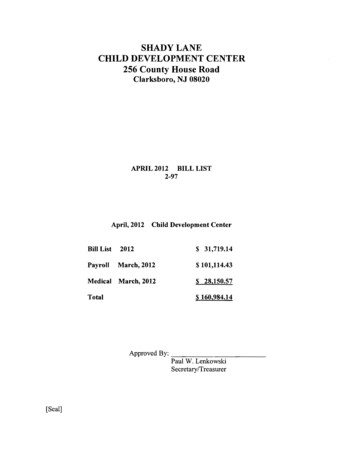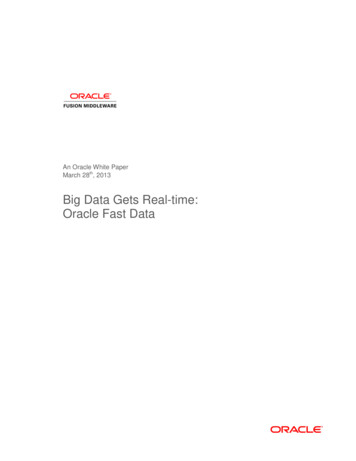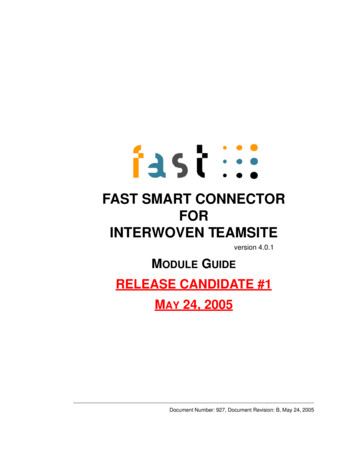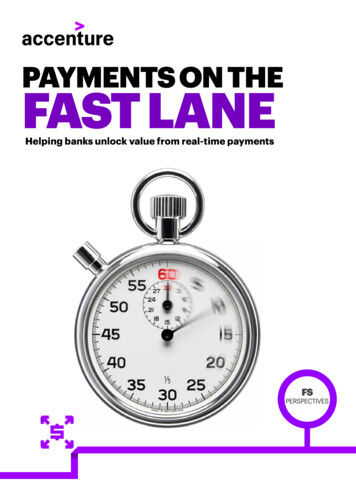
Transcription
PAYMENTS ON THEFAST LANEHelping banks unlock value from real-time payments
CONTENTSEncashing real-time paymentsTracking the real-time journeyFuelling real-time paymentsAdopting real-time paymentsUnlocking value, real-timeHow Accenture can help2
Real-time payments are becoming the new normalacross industries and banking is no exception.Digital has disrupted thepayments market, and banksin the European Union arestaring at a reduction of upto 43 percent on revenuesfrom retail payments due tothe changing dynamics inthe industry.1Can banks reinvent themselves tomatch the new pace of doing business?Yes, if they follow the trail. More in thepages that follow.3
ENCASHINGREAL-TIME PAYMENTSReal-time payments solutions (also referred to asfaster payments and instant payments) have beensuccessfully introduced in several countries acrossthe globe. However, there’s a need to analyse andunderstand their impact in terms of implementation,and supporting systems such as anti-moneylaundering (AML) and fraud detection applications,and IT systems. Impact on operational costs as wellas on other existing payment systems within thebank also need to be considered. Another factoris that real-time payments are governed by theregulator or central bank of a country, making itmandatory for banks to participate in the paymentscheme. Banks generally have an option to eitherjoin in directly or be indirect participants in theimplementation, depending on their size andcountry-specific regulatory requirements. Mostregulators also do not allow banks to recovertransaction costs from customers because they wantto promote the new payments systems. The serviceis either offered to customers free of charge or thetransaction fees are capped. As a result, banks areleft with little or no avenues to recover the costsincurred for the implementation, promotion andmaintenance of the new payments systems.The real-timepaymentsservice iseither offeredto customersfree ofcharge or thetransactionfees arecapped. So,how can banksunlock valuefrom it?This white paper outlines the various factors banksneed to consider while implementing a real-timepayments system and the ripple effect it has on itscore strategy, revenue structure and operations.We also look at strategies banks can adapt to derivebusiness value from the implementation, insteadof only focusing on return on investment (RoI). Weanalyse use cases of implementations across theglobe to study the impact on customer experience.Finally, we look at how banks’ digital strategies canevolve by embedding real-time payments, helpingthem unlock value.4
TRACKINGTHE REAL-TIME JOURNEYReal-time payments systemsenable customer paymentsin a matter of seconds, frominitiation to confirmation(see Figure 1). These systemsare now ingrained intothe payments landscapein countries that haveintroduced them.Figure 1: Real-time payments process2Customer initiation-to-confirmation speed: 1s (point of sale) - 5sAccount-to-account speed: 2sCentral infrastructure speed: tureReceivingBankMore than 40 countries have implemented real-time payments.Some countries, including Korea, Brazil and Mexico, adopted them asrecently as a decade ago, while others such as Japan and Switzerlandhave been using them for more than 30 years (see Figures 2 and 3).Figure 2: Real-time payments landscape (as of November 2018)2,3IcelandFinlandSwedenUKBelgiumSwitzerlandUS (The Clearing naBahrainIndiaKenyaMexicoGhanaHong KongThailandTaiwanPhilippinesSri LankaNigeriaJapanSingaporeBrazilChileSouth AfricaAustraliaSource: Accenture internal research5
Figure 3: Real-time payments systems under development or in planning (as of November 2018)2,3NorwayNetherlandsCanadaUK renewalHungaryUS (Federal Reserve)Saudi ArabiaPhilippinesMalaysiaNew ZealandSource: Accenture internal researchReal-time payments are gaining traction among retailbanking customers, especially during non-business hours.With real-time payments, banks can transfer funds fromthe payer to the payee instantly through changes in theirclearing and settlement processes, and acceptance ofa certain amount of settlement risk. For instance, FasterPayments Service (FPS) in the United Kingdom (UK) debitand credit the payer and the payee’s accounts respectively.The participating banks then settle their accounts withthe Bank of England through the Net Deferred SettlementScheme. The settlement risk is safeguarded to an extentthrough the reserves requirement. Banks also typicallyplace a per transaction limit and a daily cap on the fasterpayment transactions to mitigate the risk.Key functions impacted by real-time payments include thespeed of transactions, the associated downstream impact,balance between clearing and settlement mechanisms,and the settlement risk versus the cost of transactionconsideration.Real-timepaymentsare gainingtractionamong retailbankingcustomers,especiallyduring nonbusinesshours.6
Both real-time gross settlement (RTGS) systems and real-time paymentssystems transfer funds within seconds for both the payer and the payee.For banks, faster payments are settled typically up to six times a day (sixtimes a day in China, twice a day in Singapore and thrice a day in the UK).However, RTGS payments are settled instantly (see Figure 4).3,4Figure 4: Comparative study of paymentsProcessingmodeAvailabilityof fundsHigh-value payments(Real time)Retail payments(Batch)Retail payments(Real time)Single transactionFileSingle transactionReal time1–3 daysWithin seconds(SEPA credit transfer maximum24 hours)Settlement daySettlement day(Central bank operatinghours/days)(Central bank operatinghours/days)Four Corner Models* includingcentral systemCentralised approach such asautomated clearing house (ACH) ordecentralised approach such asbilateral exchangeMostly centralised modelalthough New PaymentsPlatform (NPP) in Australiauses a decentralised modelSettlementRTGSDeferred net settlement or prefundingPre-funding or deferred netsettlementDebit andcreditprocessingDebit and credit sides of thetransaction are synchronousDebit and credit sides of thetransaction are asynchronousDebit and credit sides of atransaction are synchronous,confirmation to both payerand payee immediately afterpayment completionMessageformatThe Society for WorldwideInterbank FinancialTelecommunication (SWIFT) FINSWIFT FIN/ ISO 20022ISO 20022High-value payments systemsACHPure RTGS systemsFew decentralised national systemswith bilateral file exchangeCentral real-time systemsHybrid systems24/7/365*In the traditional Four Corner Model of payment processing, the originator and the beneficiary represent the uppercorners (consumers, corporate and banks) whereas their account holding institutions (financial institutions) build thelower two corners.7
With the advent of high-speed connectivity and mobility, real-time payments systemsare redefining the way retail payments are settled and acknowledged, in line withother customer journeys and experiences (shopping, cab/hotel bookings, socialmedia, etc.). Figures 5a, 5b and 5c highlight the real-time payments landscape invarious geographies. While RTGS is available only during a fixed time, real-timepayments are available 24x7, including on bank holidays.Figure 5a: Real-time payments systems implementation status across Asia ayee speedWithin About15 secsReal timeData notavailableSettlementmodelReal ferrednetRTGSanddeferrednetReal timeVirtualaddressingE-mailaddress,mobilenumberor ccountnumberMobileData ionnumber anduniqueentitynumberMobilenumberand e-mailaddressNumber ofsettlementsper dayNil(Real time)4161MessageformatISO 20022ISO 8583ProprietaryProprietaryProprietary21ISO 20022 ISO 20022Nil(Real time)ISO 20022*NPP: New Payments Platform; IMPS: Immediate Payment Service; EBS: Electronic Banking System; BKM Express: BankalararasiKart Merkezi; FAST: Fast And Secure Transfers; FPS: Faster Payment System; ABN: Australian Business Number8
Figure 5b: Real-time payments systems implementation status across nmarkFPSBiR/SWISHJiffySICSCT InstNets 3secondsReal time10 seconds1-10 secondsDeferrednetDeferrednetDeferrednetReal timeDeferred netreal time(with TIPSlaunch inNov enumberMobilenumberMobilenumberData notavailableData notavailableNumber ofsettlementsper day3Multiple5*Nil(Real time)Data notavailable6ISO 8583ISO 20022and SWIFTFinData notavailableISO 20022(since 2016)ISO 20022ISO 20022ImplementationYearPayee speedSettlementmodelMessageformatFPS: Faster Payment System; BiR: Betalningar i Realtid; SIC: Swiss Interbank Clearing System; SCT Inst: SEPA Instant CreditTransfer; TIPS: TARGET Instant Payments Settlement* Jiffy, the Italian system, is based on SCT and thus payments can be cleared and settled in any SEPA complaint clearingand settlement mechanism (CSM). The actual number of settlement batches depends on the design of each CSM. Thenumber refers to the Italian CSMs and the European CSM STEP2.9
Figure 5c: Real-time payments systems implementation status across the Americas and Africa3,4MexicoBrazilSouth 002200620080-60seconds 1 minute0-60seconds 15 secondsReal timeContinuousnet settlementDeferrednetDeferrednetData not availableNot availableData not availableData not availablePayee speedSettlementmodelVirtualaddressingNumber ofsettlementsper dayReal time#24,2 or 1* – outsidebusiness hoursProprietaryMessageformatNot available3 – normalbusiness hoursExtended mark-uplanguage (XML)-basedmessaging systembut will be movingto ISO 20022 inthe near futureISO 8583ISO 8583SPEI: Sistema de pagos electrónicos interbancarios; SITRAF: Sistema de Transferência de Fundos (Funds Transfer System); RTC:Real Time Clearing Payments; TEF: Transferencias en Línea* Four times on week days, twice on Saturdays and once on Sundays and public holidays# Several batches (every three seconds or whenever more than 300 payments are queued, whichever occurs first)!"# %&%'!10
As shown in Figures 5a, 5b and 5c, eachcountry has its unique framework forreal-time payments and implementation.While there is no standard globalframework, many have used the ISO 20022standard for their messaging formatswhich is increasingly gaining acceptanceglobally. Apart from the messagingformats, the overall frameworks aredesigned by regulators in each country,based on specific goals. Each countryhas its own goals and opportunities forfaster payments, and these depend onthe consumer patterns prevalent in thecountry.For example, in the emerging markets, thereare more mobiles than bank accounts. Hence,the regulator’s goal would be to drive real-timepayments with a broader target towards financialinclusion. In some countries like Poland, wherecredit cards are less prevalent, real-time paymentsare targeted at driving e-commerce.Broadly, the factors nudging banks towardsreal-time payments implementation are theunderlying customer need for immediacy, ease andconvenience. The rise of independent FinTechsand the recent surge in blockchain technologycompanies have also fuelled the move.11
FUELLINGREAL-TIME PAYMENTSDespite the high initial costs, real-time payments systems have become thenorm due to the following reasons:1Customer expectations for immediate fund transfers25Merchant expectations for real-time settlement andfunds availability3Better customer experience4Competition from early adopter payment serviceproviders and banksCompetition from FinTechs6Market competition (if banks do not offer real-time payments,customers might move to others that do, creating losses not justin payments but other banking functions as well)For banks, the writing is on the wall. Instead of focusing only oncosts and benefits of real-time payments, they need to considerhow this solution can add value to their overall business.1212
PROJECT UBIN:REAL-TIME IN ACTIONAccenture partnered with the Monetary Authority ofSingapore (MAS) and the Association of Banks in Singapore(ABS) for a collaborative project with 11 financial institutionsand four technology partners.AIMThe aim was to explore the use of distributed ledger technology (DLT) forspecific RTGS functionalities. Mainly, the project focuses on the feasibilityof decentralising Liquidity Saving Mechanisms (LSM), while maintainingthe privacy of banking transactions.WHAT WE DIDLeveraging the capabilities of the Accenture Liquid Studio and its LiquidDelivery Methodology with Microsoft Azure as the cloud platform, threeprototypes were developed on three different DLT platforms: Corda,Hyperledger Fabric and Quorum.The prototypes successfully demonstrate that: Essential functions of an RTGS system such as fund transfer, queueingmechanism and gridlock resolution can be achieved through differenttechniques and solution designs. Decentralising the key functions of an RTGS system may not onlymitigate the inherent risks of a centralised system, such as singlepoint of failure but may also affirm the promised benefits of DLT, forexample, cryptographic security and immutability.Given that privacy is paramount in an interbank payment system, thisproject validates that all workstreams may ensure the privacy of RTGStransactions with their distinct methods. Specifically, Corda with itsUnspent Transaction Output (UTXO) model and confidential identities,Hyperledger Fabric leveraging its Channels design, and Quorum usingConstellation and zero-knowledge proofs (ZKP).13
RESULTSAccenture helped these banks understand the implications ofimplementing RTGS systems and devise a digital strategy.Ubin Phase 2 successfully demonstrates the use of DLTto decentralise RTGS without compromising privacy.It concluded that all three workstream designs havesuccessfully demonstrated the feasibility of removinga central infrastructure operator in a DLT-based RTGSsystem. The project demonstrated Accenture’s globaland local capabilities in DLT and the global financialmarket innovations.For the first time, proven Liquidity Saving Mechanism (LSM) wasused on Distributed Ledger Technology (DLT) while preservingtransactional privacy.14
ADOPTINGREAL-TIME PAYMENTSAdopting real-time payments is not just aboutimplementing a new technology. Banks must also considerthe impact they have on other internal functions. Some keyfactors to consider are:Impact onrevenue andother paymentssystemsRevenue loss infloating incomeStrictservice-levelagreementsImpact onAML, n andoperational)impact15
Impact on other payments systems within the bankThere have been various studies on the impact of real-time payments on the existingpayments systems in banks. Research suggests that cash payments are leastimpacted as they are still the preferred mode of payment in developing economies.5RTGS and batch payments are also hardly impacted as they are primarily used forhigh-value transactions and one-to-many payment instructions.Revenue loss due to a reduction in floating incomeTraditionally, payment settlements happen overnight, resulting in banks gettingflushed with settlement funds earning floating income from overnight investments.In real-time payments, settlement cycles are completed during the day, removingthe floating revenue stream. As a result, the cost and revenue models of real-timepayments are significantly impacted.Strict service-level agreements (SLAs)Banks need to rethink and realign their SLAs for real-time payments. The impactof running 24x7 systems and the non-functional requirements would need to beassessed. Banks need to increase transactions-per-second processing to dealwith large, low-volume transactions and ramp up operational teams to handle andresolve support-related issues 24x7.Real-time fraud detection and AML checksFor real-time payments, banks must reconsider their security measures and enhancetheir infrastructure to enable online fraud detection systems and AML checkpointsduring transactions. To be successful, this would not only mean revamping thesystems, but also implementing robust solutions for real-time AML checks.16
Cost impactIt is also important to understand the various costs involved in implementing realtime payments systems. The costs can be classified into the following ationalcostsDevelopment costsTransaction feeCosts for trainingCustomisation costsCommissions to be paidto sponsor banks (in caseof indirect participants)Operational costs formaintenance of the teamto manage settlementand reconciliationsConnectivity costs toconnect the core bankingsystem with the real-timepayment solutionConnectivity costs toconnect with the serviceprovider/regulator/centralbankFee to be paid to networkoperators such as mobilenetworksAnnual maintenancecostsMarketing, promotionsand advertising costsConnectivity costs toconnect with gateways/merchantsCost for setting up POSand maintenance, etc.(mobile apps or NFCenabled communications)Fixed costs such as thefee for installation ofswitches, etc1717
For example, the costs for the UK Faster PaymentService implementation touched approximately 0.7–20 million per bank, with the FinancialConduct Authority (FCA) pegging the entirecost of implementation at approximately 200million, centrally.6The FCA had estimated that the maintenancecosts would run up to 150–230 million over aseven-year period among 12 banks that startedand owned the project. The costs could fall asmore banks join the network.These costs could drain the banks’ funds with very little scope forrevenues unless customers are charged a transaction fee. An Accenturestudy shows that cost per transaction can be brought down if the numberof transactions is significantly high (see Figure 6).Figure 6: Direct membership costs to volumes for FPS UKDirect membership (RT)1.4 m transactionsAverage annual FPS transactional volumein million13 m transactions18
UNLOCKINGVALUE,REAL-TIMEImplementing real-time payments systemsprovide a big opportunity for banks toderive business value, instead of RoI alone.Although there are little or no avenues torecover costs, aligning their long-termdigital strategy to real-time paymentssystems can help banks unlock valueand gain a competitive advantage. Realtime payments can be used in varioususe cases in the banks’ digital strategy toprovide customers and merchants witheasy, convenient and real-time solutionsto existing problems for transactions andsettlements. What drives value to the varioususe cases is summed up by how they areinstant, invisible and free.7 Read our nextsection to know more about the strategiesfor real-time payments, and how they arehaving far-reaching implications acrossgeographies than initially understood.1919
STRATEGIESFOR REAL-TIMEPAYMENTSDefine the implementation plan,phases and rollout strategy.Is the plan scalable and open tochanges?Compare the value propositionwith market solutions.Are the controls for risk andmitigation in place and arethey working?Shortlist partners and vendorswith innovative solutions based onmarket trends.Assess the value creationagainst costs.IMPLEMENTS FORGIETERASTPrioritise theproduct backlog andstrategise phase-wiseimplementation.COMPAREPRIORITISEDo they fit into the bank’sdigital strategy?Does the real-timepayment use case bringsufficient business value tocustomers and merchants?ASSESSADOPTHow can we adopt apayment system for
Merchant expectations for real-time settlement and funds availability Competition from FinTechs. REAL-TIME PAYMENTS . UNLOCKING VALUE, REAL-TIME .
